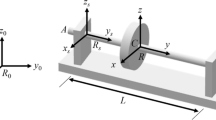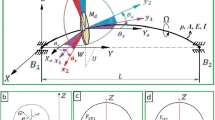Abstract
In this paper, an investigation regarding the dynamic behavior of a rotating machine subjected to a base excitation is presented numerically. Regarding aeronautical applications, the aircraft engine is considered a typical onboard rotor that has its dynamic behavior influenced by base excitations. The mathematical model of the machine is derived from the finite element method, which is obtained by considering the strain and kinetic energies of the rotor subsystems (shaft, discs, bearings, mass unbalance, etc.). The resulting differential equations are used to provide information about the vibration responses of the rotor under base and unbalance excitations, simultaneously. The rotating machine used in this work is represented by a horizontal flexible shaft containing two rigid discs and supported by two ball bearings. In this case, the base of the rotor system is considered as being rigid. Therefore, the proposed analysis is performed both in the time and frequency domains, as generated by the orbits, unbalance response, and Campbell diagram of the rotor. This study illustrates the differences between fixed and onboard rotors, focusing on the dynamic behavior of the system.















Similar content being viewed by others
References
Cavalca KL, Cavalvante PF, Okabe EP (2005) An investigation on the influence of the supporting structure on the dynamics of the rotor system. Mech Syst Signal Process 19(1):157–174
Cavalini AA Jr, Lara-Molina FA, Sales TP, Koroishi EH, Steffen V Jr (2015) Uncertainty analysis of a flexible rotor supported by fluid film bearings. Latin Am J Solids Struct 12(8):1487–1504
Cavalini AA Jr, Lobato FS, Koroishi EH, Steffen V Jr (2015) Model updating of a rotating machine using the self-adaptive differential evolution algorithm. Inverse Probl Sci Eng 24(3):504–523
Dakel M, Baguet S, Dufour R (2014) Steady-state dynamic behavior of an on-board rotor under combined base motions. J Vib Control 20(15):2254–2287
Das AS, Dutt JK, Ray K (2010) Active vibration control of unbalanced flexible rotor-shaft systems parametrically excited due to base motion. Appl Math Model 34(1):2353–2369
Duchemin M (2003) Contribuition à l’étude du comportement dynamic d’un rotor embarqué. PhD thesis, INSA Lyon, Lyon
Duchemin M, Berlioz A, Ferraris G (2006) Dynamic behavior and stability of a rotor under base excitation. ASME J Vib Acoust 128:576
El-Saeidy FMA, Sticher F (2010) Dynamics of a rigid rotor linear/nonlinear bearings system subject to rotating unbalance and base excitations. J Vib Control 16(3):403–438
Hori Y, Kato T (1990) Earthquake-induced instability of a rotor supported by oil film bearings. ASME J Vib Acoust 112(2):160–165
Lalanne M, Ferraris G (1998) Rotordynamics prediction in engineering. Wiley, Chichester
Lei H, Yushu C (2014) Dynamical simulation and load control of a Jeffcott rotor system in Herbst maneuvering flight. J Vib Control 1(1):1–14
Marx S, Nataraj C (2007) Suppression of base excitation of rotors on magnetic bearings. Int J Rotat Mach 1(1):1–10
Storn R, Price K (1995) Differential evolution: a simple and efficient adaptive scheme for global optimization over continuous spaces. Int Comput Sci Inst 12(1):1–16
Acknowledgements
The authors are thankful to the Brazilian Research Agencies FAPEMIG (APQ-307609) and CNPq (INCT-EIE—574001/2008-5) and also to CAPES for the financial support provided to this research effort.
Author information
Authors and Affiliations
Corresponding author
Additional information
Technical Editor: Kátia Lucchesi Cavalca Dedini.
Appendix
Appendix
Equations (17) and (18) present the damping and stiffness matrices of the discs, respectively, obtained by considering the motion of the rotor base.
in which I Dm = (I Dx + I Dz )/2.
Equations (19) and (20) present the damping and stiffness matrices of the shaft, respectively, obtained by considering the motion of the rotor base.
where M 2 and M 4, K 2, and D 1 are mass, stiffness and damping matrices, respectively, which depend only of the length L (see Fig. 4). The stiffness matrices K 1 and K 3 are also dependent on \(\dot{\alpha }_{s}\), \(\dot{\beta }_{s}\), and \(\dot{\gamma }_{s}\).
All these matrices and the ones common to the fixed base rotor can be seen in Duchemin [6].
Rights and permissions
About this article
Cite this article
Sousa, M.S., Del Claro, V.T.S., Cavalini, A.A. et al. Numerical investigation on the dynamic behavior of an onboard rotor system by using the FEM approach. J Braz. Soc. Mech. Sci. Eng. 39, 2447–2458 (2017). https://doi.org/10.1007/s40430-016-0640-5
Received:
Accepted:
Published:
Issue Date:
DOI: https://doi.org/10.1007/s40430-016-0640-5




